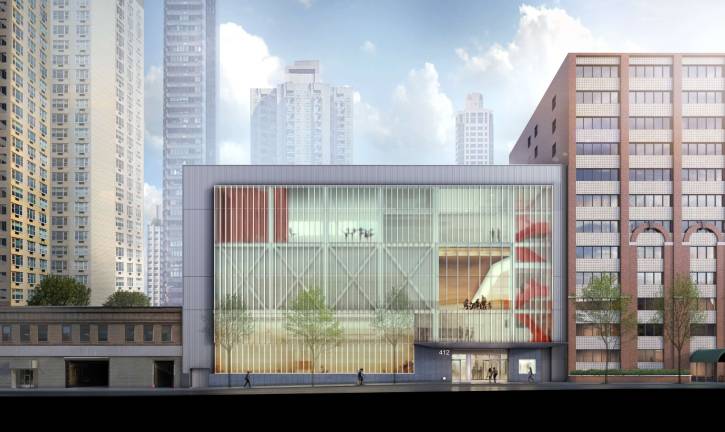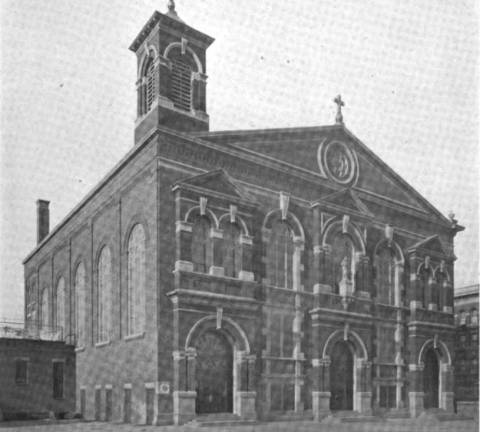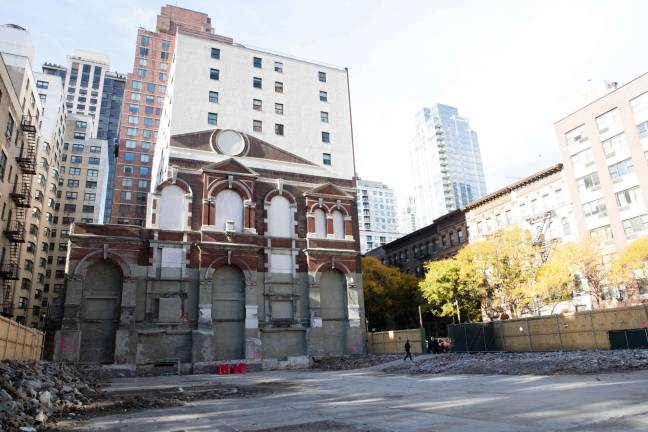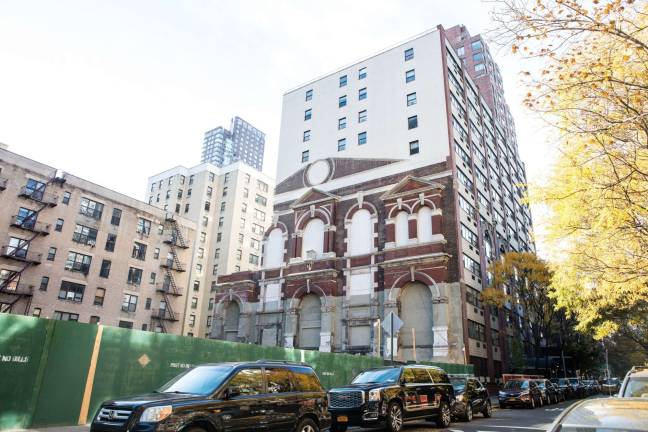the ghostly remnant




A monumental, long-forgotten Yorkville treasure has resurfaced from out of the past on a quiet crosstown block on East 90th Street — but it is quickly expected to disappear from sight.
Upper East Siders wishing to glory in its grandeur and other-worldliness must not tarry: Later this year or in 2020, it is set to vanish — perhaps for generations, perhaps indefinitely.
When that happens, the last vestige of an historic superblock that once offered meals, housing, schooling and Catholic discipline to impoverished orphans of German origin will be gone forever.
This is a story about relics, religion, real estate, parking garages, preservation — and passion for lost causes.
Ultimately, it’s about a 2011 property deal between Hertz Rent-a-Car and the Spence School that initially restored a piece of the past to the Manhattan streetscape, but is now threatening to sever it for good.
The object in question is an architectural remnant, a surviving fragment from an imposing neo-Classical, brick-and-stone church. Only a single element of the original superstructure still stands — its facade. But what a facade.
It boasts exquisite ornamentation, detailed pediments, a circular rose window, decorative arched window openings and large Romanesque arches that once provided entry for prayer services.
Those architectural remains are all that’s left of St. Joseph’s Orphan Asylum, which was founded in 1857, ministered to thousands of abandoned children and owned the entire city block bounded by 89th and 90th Streets and First and York Avenues.
It was on that sprawling campus that the orphanage in 1898 built a hall for its young charges at 402 East 90th St. that was converted in 1907 to serve both orphans and local parishioners as St. Joseph’s main chapel.
As a sacred site, its reign was brief. By 1918 — with the end of World War I in sight and UES land values soaring — the orphanage began to sell off its multiple institutional buildings to developers.
Before long, one of Yorkville’s earliest munificent organizations had moved to Peekskill. But though its chapel went out of business, it never left the block.
“It would have been deconsecrated,” said Father Boniface Ramsey, the pastor of St. Joseph’s Church on East 87th Street, which was built in 1894 for the German-speaking parish and was affiliated with the orphanage.
The purchaser would have been chosen with great care, the priest said. “The Archdiocese wouldn’t sell it to someone who would turn it into a bordello,” he added.
Indeed, the buyer, and a second buyer 65 years later, turned out to be deeply respectful of its ecclesiastical legacy.
THE AUTO AND THE CONDO ENTER THE CHAPELThe auto was playing an ever-larger role on city streets, and a decade after the first Model-T rolled off the assembly line in 1908, plans were unveiled to remodel the church as a parking garage for 250 cars, a 1918 New York Times story reported.
Its new owner, opting to retain the facade, essentially inserted a two-story garage within the church’s nave and clerestory. Meanwhile, three other two-floor parking garages quickly popped up on 90th Street between First and York.
Flash forward to 1983: Another owner bought the chapel-cum-garage, added several stories, converted it into a 12-story condominium. Again, the entryway survived and was embedded into the rebuilt structure.
“A curious decision was made to retain the east facade and incorporate it into the larger residential building, creating a flattened, almost trompe l’oeil effect when viewed from the street,” said Rachel Levy, the executive director of the Friends of the Upper East Side Historic Districts, which is documenting the site.
Along 90th Street, church arches became structural elements of the “boxy” 1980s facade, creating a “postmodern combination of old and new,” she said.
For years, the view of the church’s primary facade, which rises about 65 to 70 feet in height, was truncated. Directly to its east, at 412 East 90th St., a neighboring garage, eventually purchased by Hertz, stood roughly 40-feet high, effectively masking the structure’s lower half.
Enter the prestigious Spence School, an all-girls K-12 school whose own history in the neighborhood runs deep: Founded in 1892, it moved to 91st Street in 1929.
In Sept. 2011, Spence paid $26 million to purchase the garage adjoining the church from Hertz Corp., records show. Then last year, it razed the structure. For the first time in a century, the full majesty of the church came into view.
Not for long. Spence late last year began excavation and foundation work for a 54,000-square-foot athletic complex on the site that will include a regulation-sized basketball court, nine squash courts, study centers, performing arts space and a greenhouse.
The problem: The six-story building will rise 85 feet and totally obscure the St. Joseph’s chapel fragment.
“The new Spence building at 412 East 90th St. will abut the brick-and-stone wall, but all primary structure is set back from the protruding elements of the remnant wall,” Spence said in a statement.
“When the new building is finished, the masonry wall will not be visible,” the school confirmed.
Father Ramsey says it must be saved and in view. “It’s a fascinating piece of history,” he said. “It’s curious and stunning that it survived. It should not be covered up.”
Community leaders are hoping for a creative solution:
“I think it would be really cool if Spence chooses to put up a glass curtain wall so that students who use the facility can actually see this architectural feature on the side of the building,” said East Side City Council Member Ben Kallos.
The clock is ticking. Levy says the object that will be “effectively erased” is “perhaps the last extant piece of this particular strain of Yorkville’s history.”
“The neighborhood is changing left and right, and if the facade remnant could be retained in some way, it could be a great opportunity to illuminate some of our collective history,” she adds.
invreporter@strausnews.com